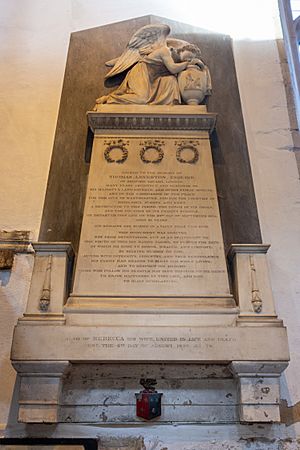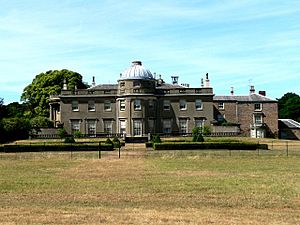Thomas Leverton facts for kids
Thomas Leverton (born around 1743 – died September 23, 1824) was a talented English architect. He designed many buildings, from grand country houses to important offices in London.
Contents
Early Life and Training
Thomas Leverton was born in Waltham Abbey, Essex. He was baptized on June 11, 1743. His father, Lancelot Leverton, was a builder. Thomas learned the building trade from his father. Later, with help from people who supported him, he gained the skills to become an architect.
Designing Buildings
Leverton designed homes in both London and the countryside. One of his notable works was Watton Wood Hall (now Woodhall Park) in Hertfordshire, built between 1777 and 1782. This house featured a special hall decorated in an "Etruscan style." In 1780, he designed Plaistow Lodge (now Quernmore School) in Kent. He also updated Scampston Hall in Yorkshire in 1803, adding a dome.
Some other houses he designed included Woodford Hall in Essex (built 1775, now gone) and Riddlesworth Hall in Norfolk (built 1792).
In the grounds of Parlington Hall in Yorkshire, Leverton built a special triumphal arch. This arch celebrated the American victory in the War of Independence. He even showed his design for this arch at the Royal Academy in 1781.
Work in London
Leverton is sometimes thought to have designed Bedford Square in London. While this is not fully certain, he is known for designing some of the individual houses there. He also designed the inside of many homes, including No. 13 Bedford Square, where he lived starting in 1795. He was especially good at creating new and interesting designs for the inside of smaller rooms.
He worked as a surveyor for several important groups. He built a new hall for the Grocers' Company, which was finished in 1802. He also worked for the royal theatres in London and the Phoenix Fire Insurance Company. For the insurance company, he built offices in Lombard Street around 1787 and a fire engine house at Charing Cross. Both of these buildings were later taken down.
Leverton also worked for the Department of Land Revenue. He and his student, Thomas Chawner, suggested a plan to improve Marylebone Park Farm (now Regent's Park) in 1811. However, the plans by another architect, John Nash, were chosen instead.
One of Leverton's students was Stephen Geary, who later became famous for founding and designing Highgate Cemetery.
Thomas Leverton showed his architectural designs at the Royal Academy from 1777 until 1803. He was also a Justice of the Peace (JP) for several areas, including Westminster, Middlesex, Surrey, and Kent.
Family Life
Thomas Leverton was married twice. His first marriage was in 1766. In 1803, he married Rebecca Craven. Sadly, his only son passed away before him. His niece married one of his students, James Donaldson. Their son, Thomas Leverton Donaldson, later became a Professor of Architecture at London University.
Death and Lasting Impact

Thomas Leverton died at his home at 13 Bedford Square, London, on September 23, 1824. He was buried in Waltham Abbey. A monument to him was created by the sculptor Josephus Pinnix Kendrick.
Leverton left money in his will to start the Thomas Leverton Charity. This charity was created to help women who were struggling, especially widows living in certain parts of London. This charity has since joined with another larger charity.
Key Works
- Woodford Hall in Essex (built 1775; now gone)
- Watton Wood Hall (now Woodhall Park), Hertfordshire (built 1777–82)
- Triumphal Arch, Parlington Hall, Yorkshire (built around 1781–83)
- Riddlesworth Hall in Norfolk (built 1792)
- Grocers' Hall, City of London (1798–93; now gone)
- Scampston Hall, Yorkshire (redesigned in 1803)
- 4 Hamilton Place, Mayfair, London (1807-1810)
- 5 Hamilton Place, Mayfair, London (1807-1810)
- Gordon House, Chelsea (built 1809)
- Office for the Phoenix Fire Insurance Company, Lombard Street, London (now gone)
- Fire engine house at Charing Cross (now gone)
|



